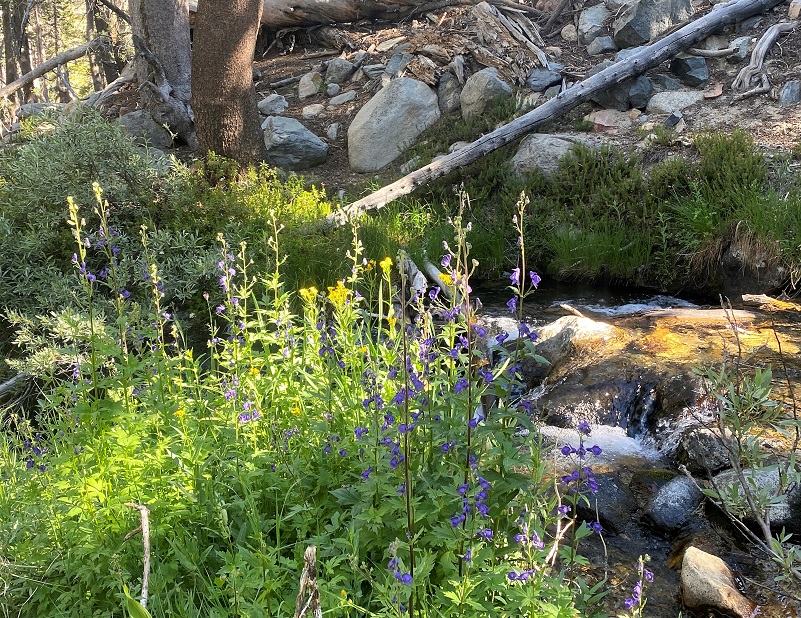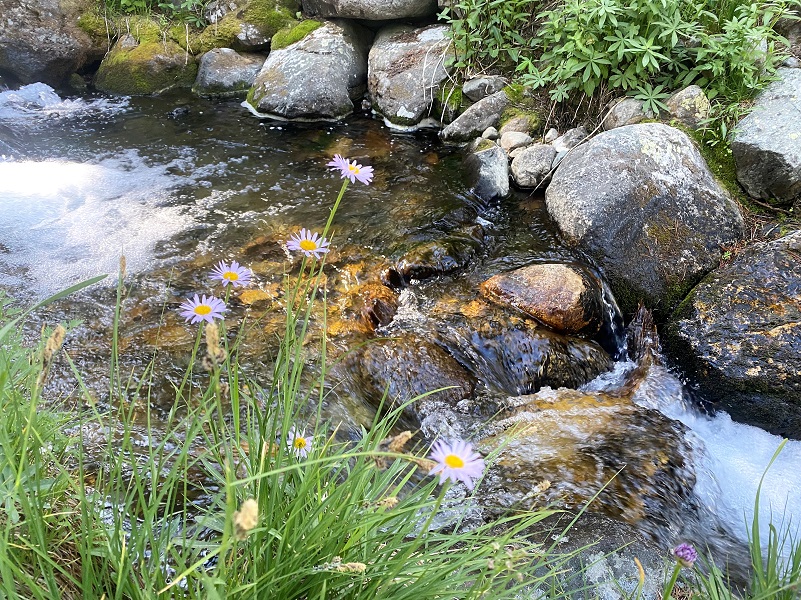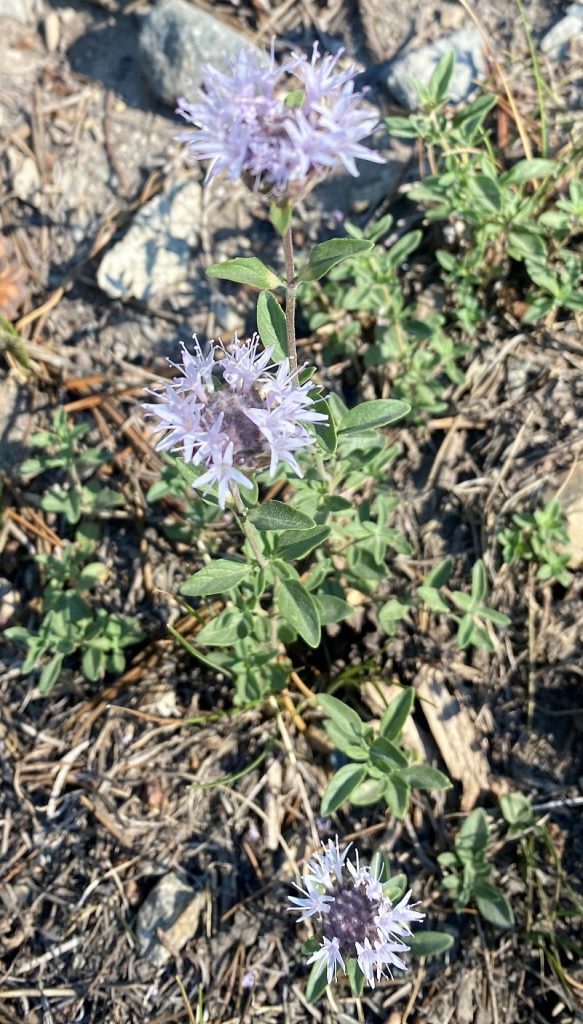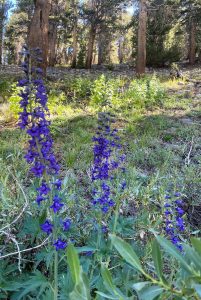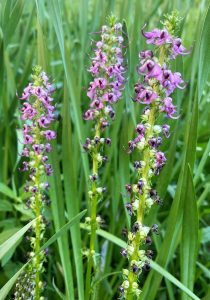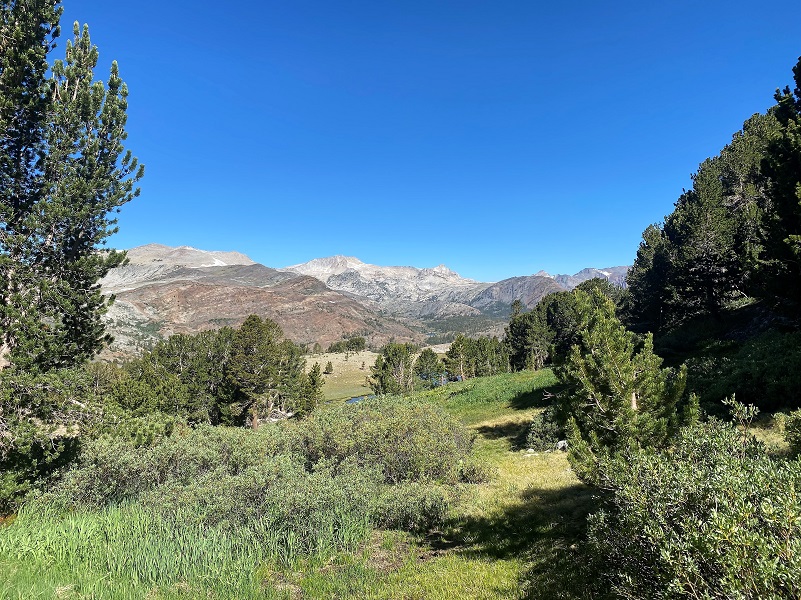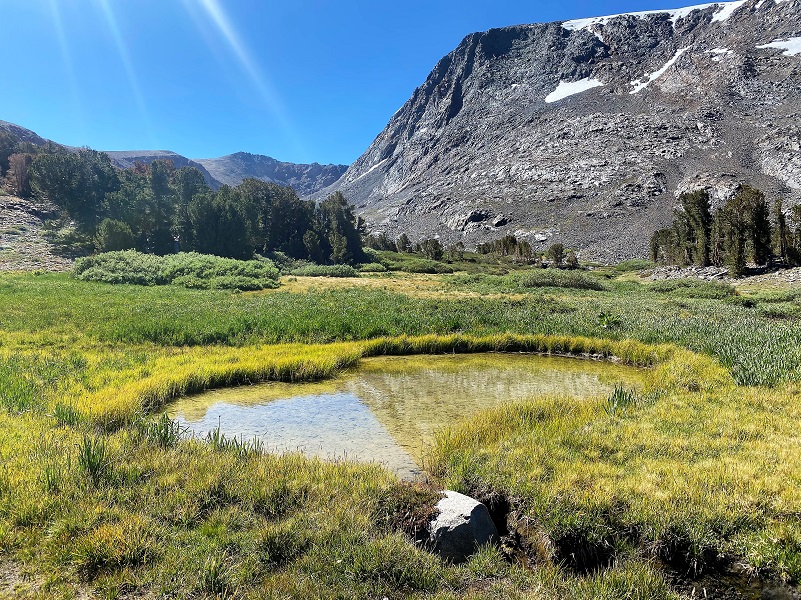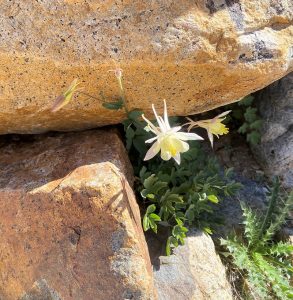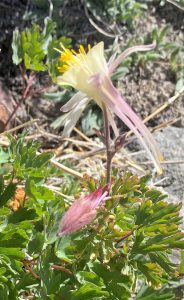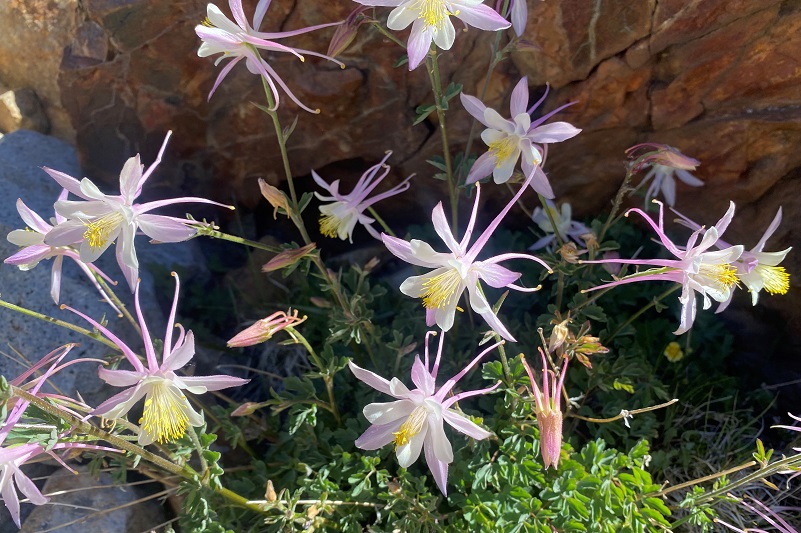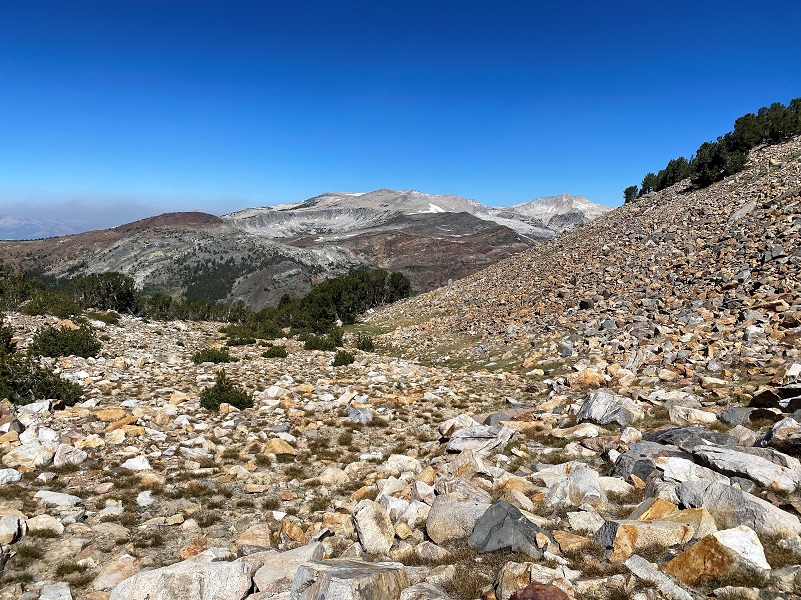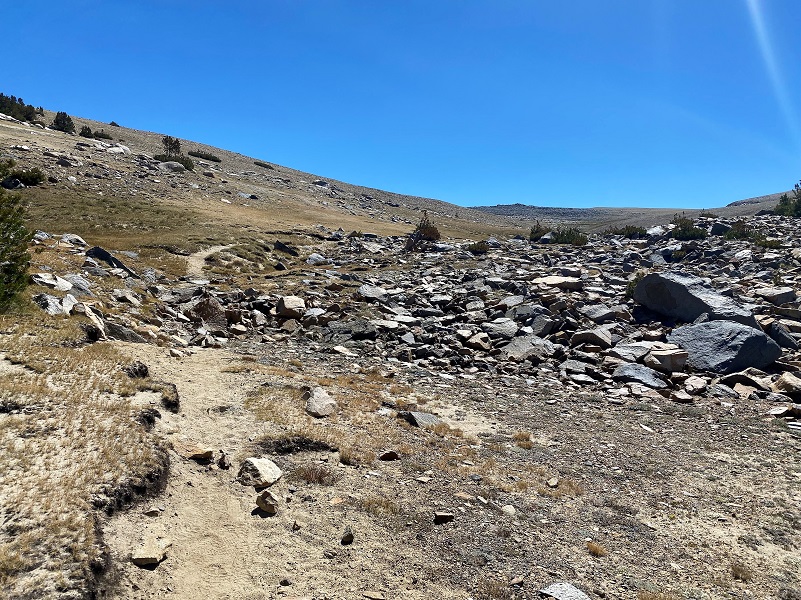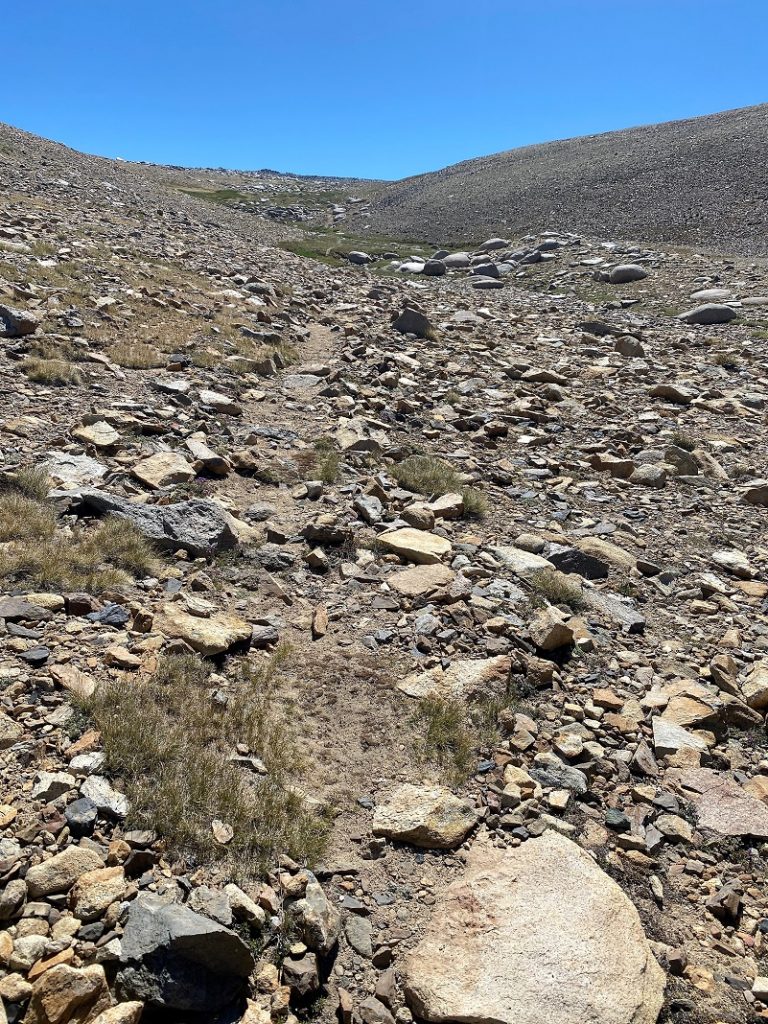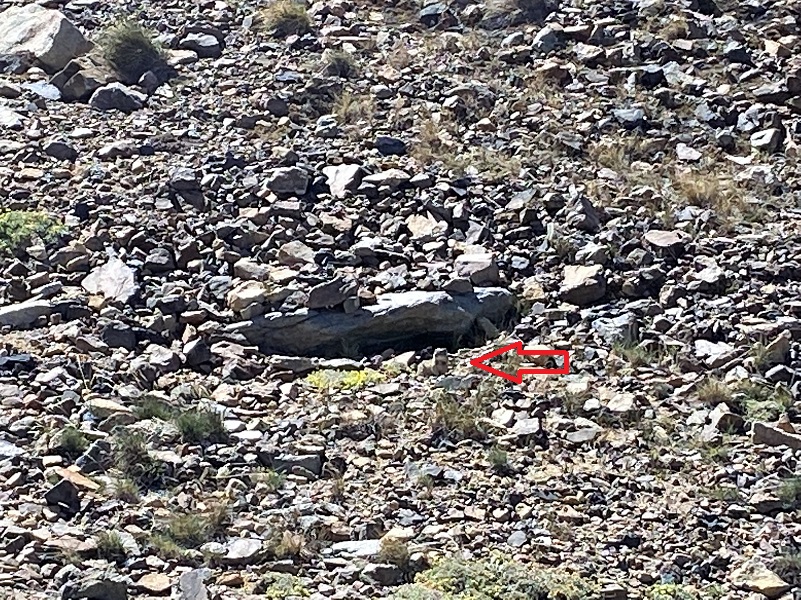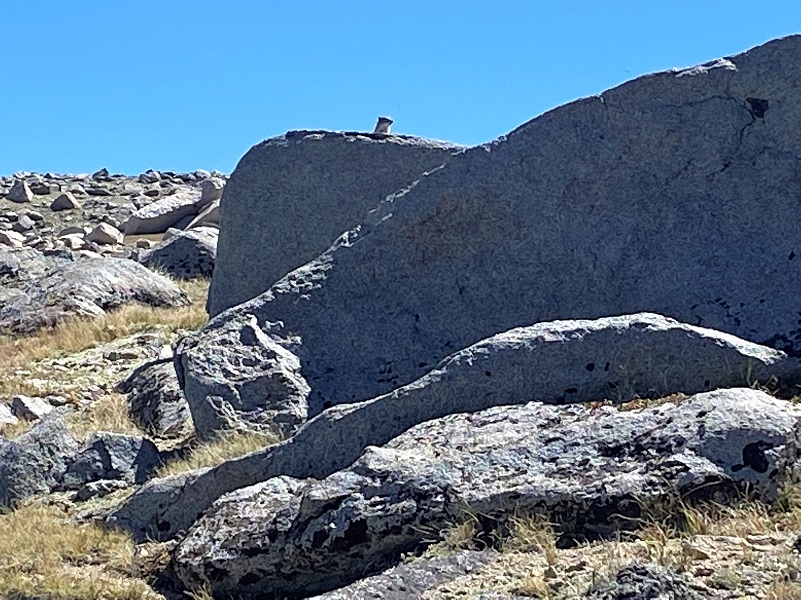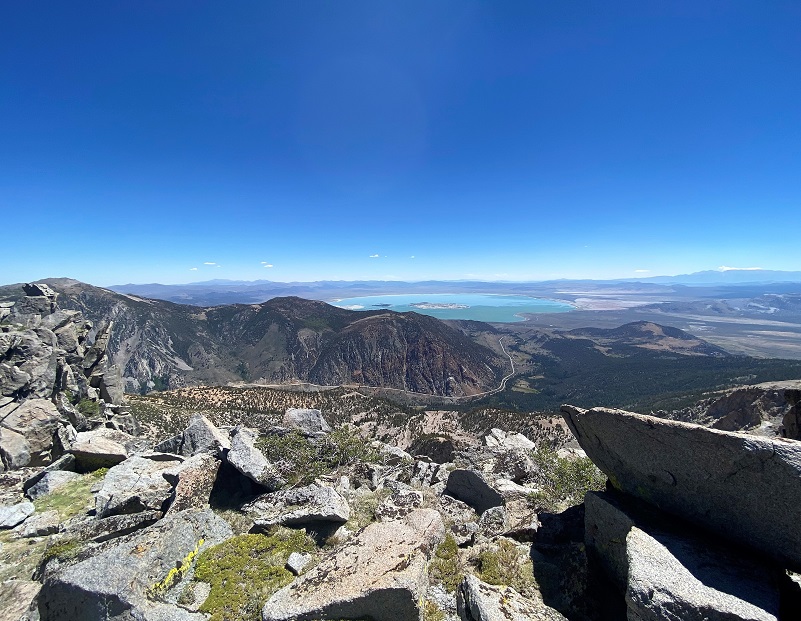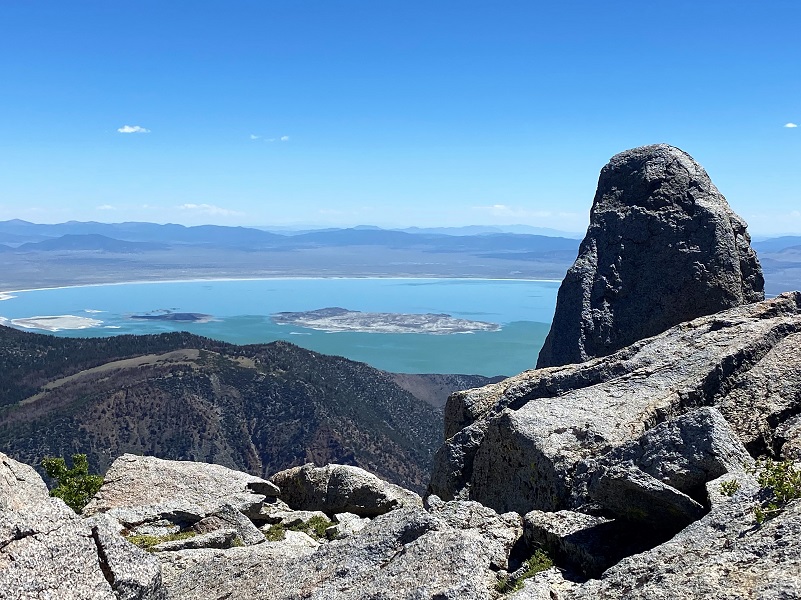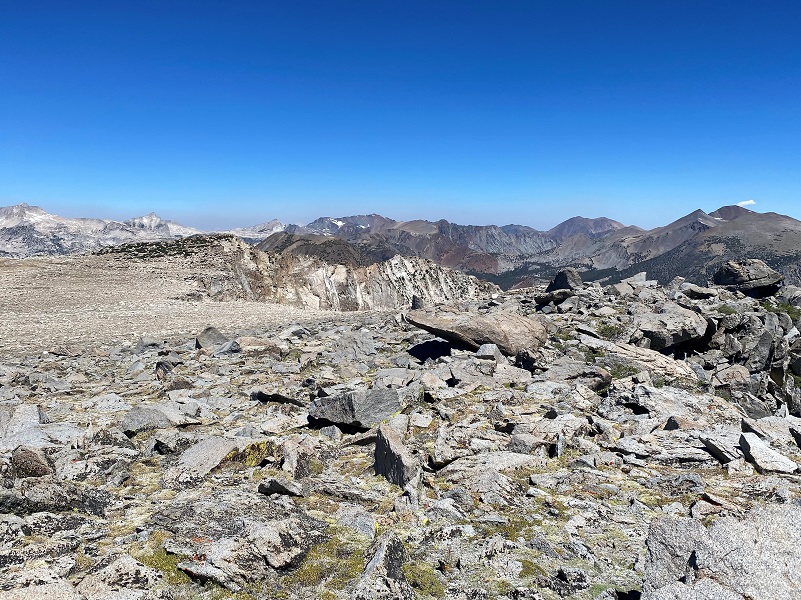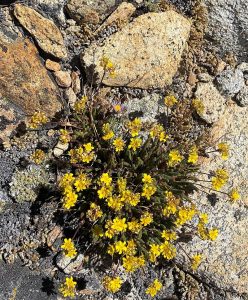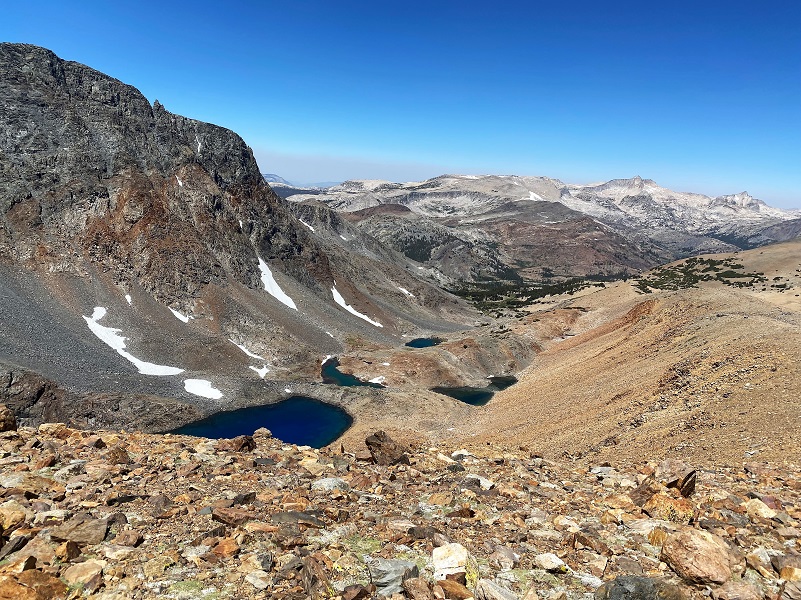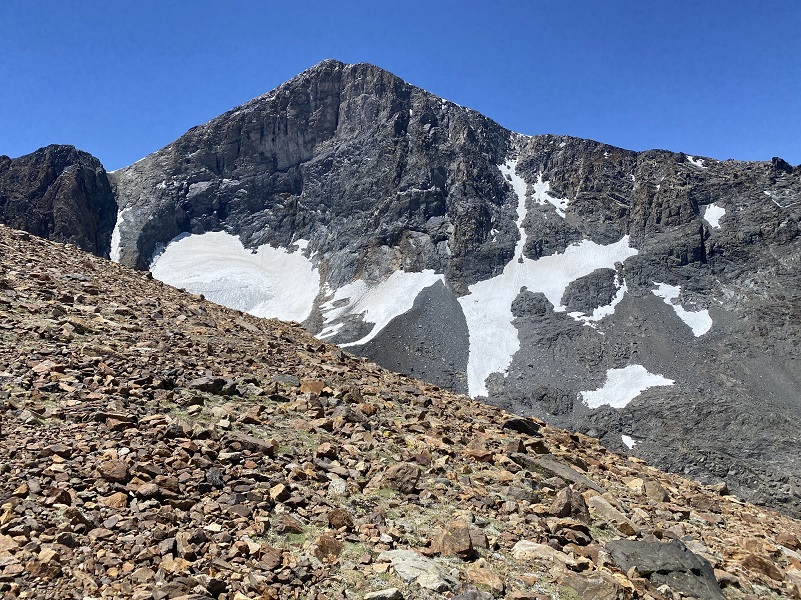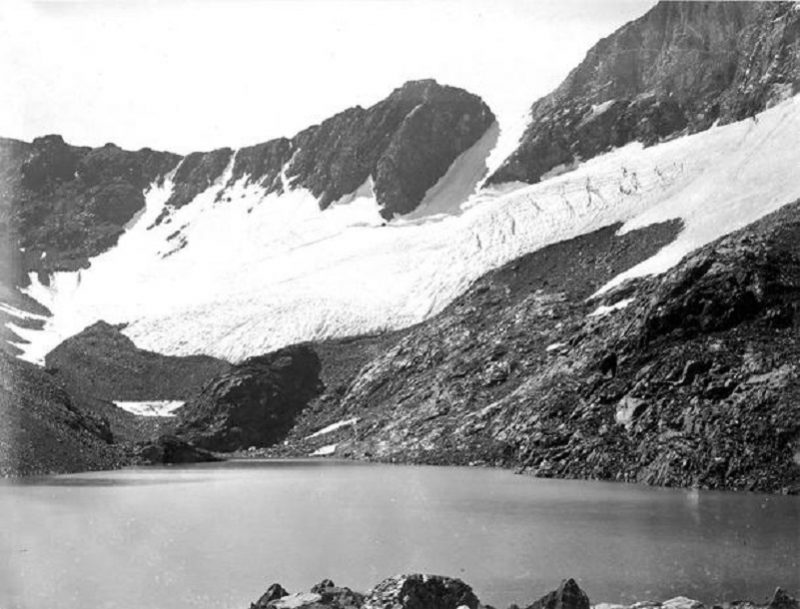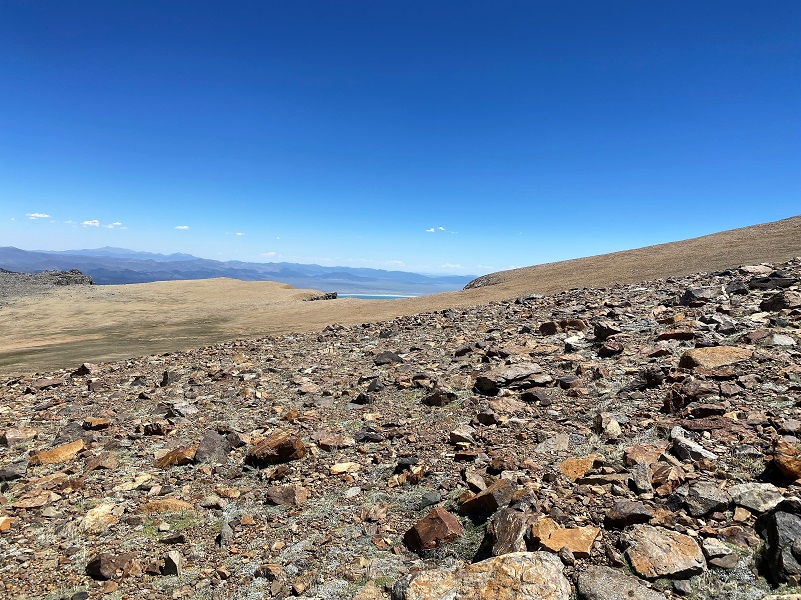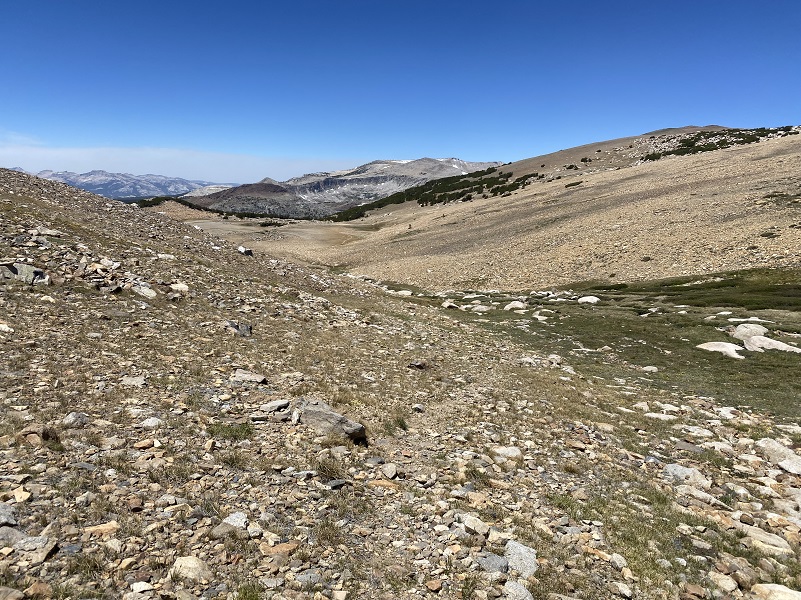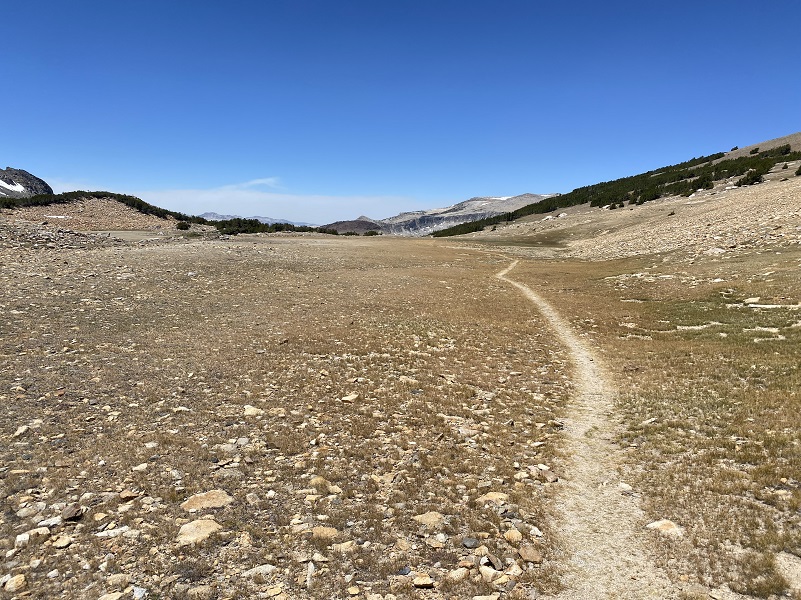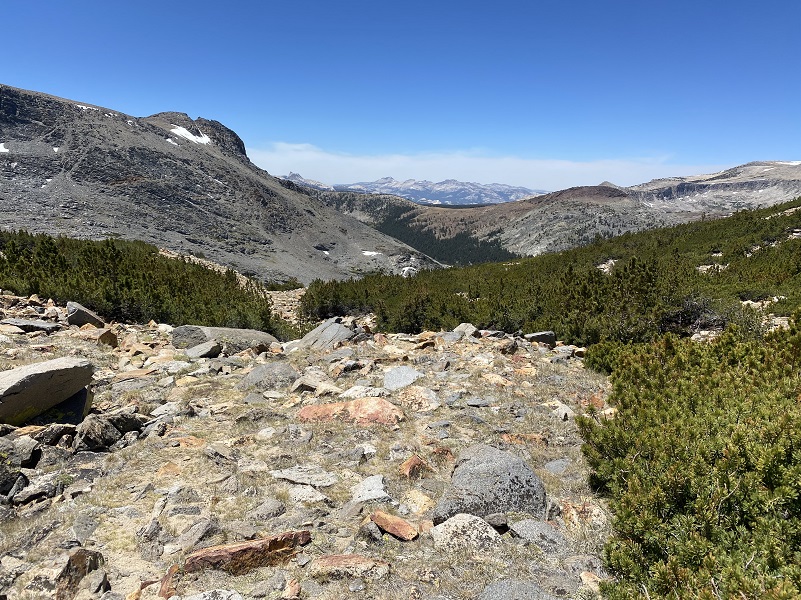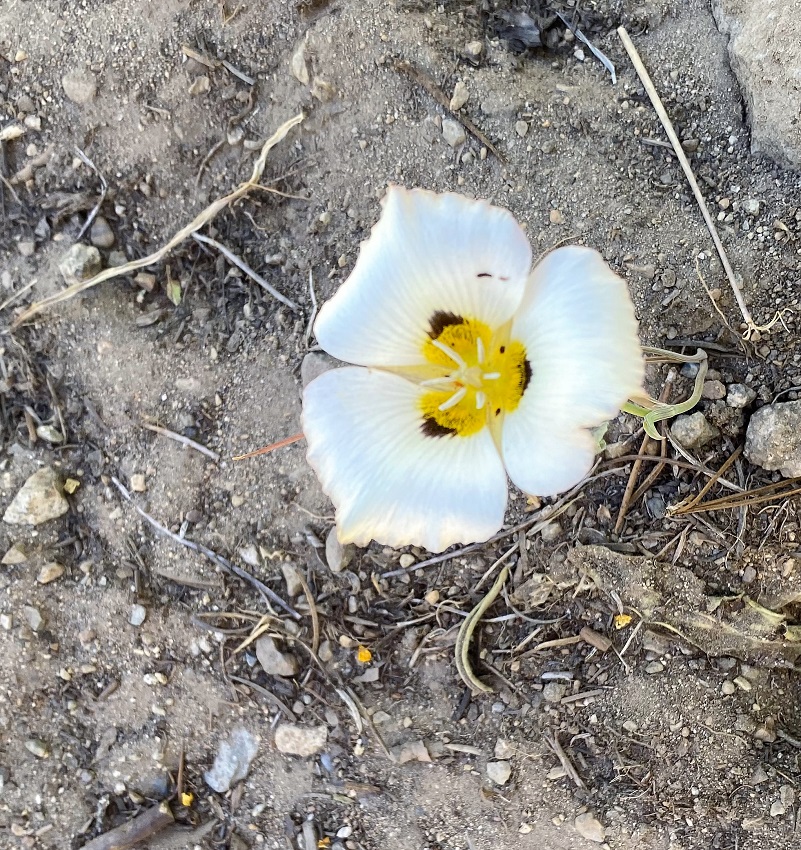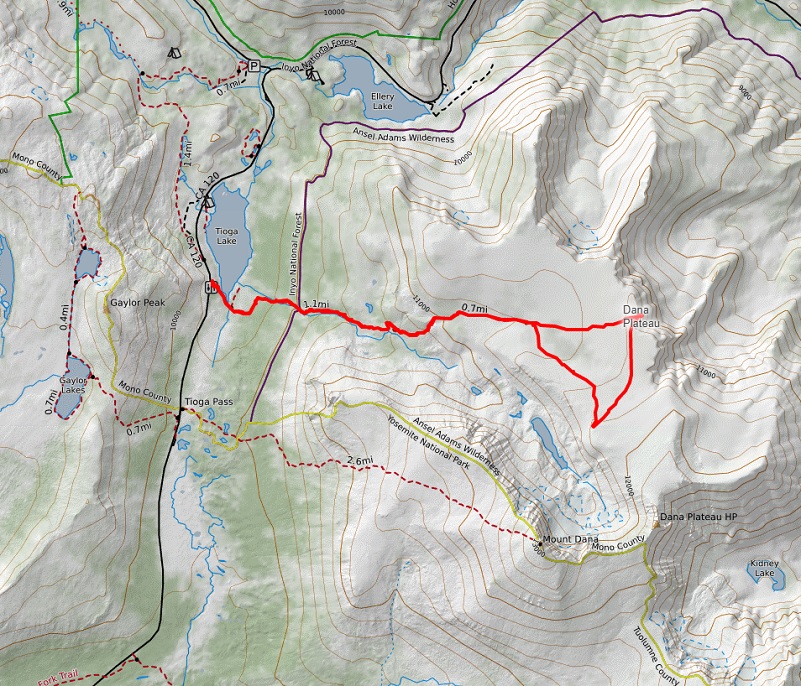Smoke from the Washburn Fire wasn’t going to stop me from having an adventure this week so I closely researched weather and smoke models, finding the perfect day in the Tioga Pass area for those breezy Zephyr winds to keep the skies clear over me. A bounty of colorful wildflowers along the way led me up to Dana Plateau with incredible views of Mt. Dana and Mono Lake. And there were pika!
Where: Ansel Adams Wilderness Area, Inyo National Forest
Distance: 7.3 Miles (5.69 miles to the Mono Lake overlook)
Difficulty: Strenuous
Elevation Range: 9,654′ – 11,838′
Elevation Gain: 2,300′
Date: July 14, 2022
CALTOPO: Up and Around Dana Plateau
Dog Hike? Probably not
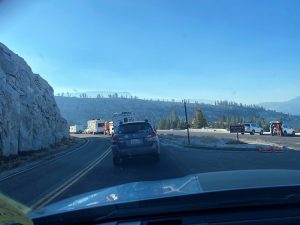 I headed into Yosemite National Park via the Arch Rock Gate, arriving at 7:05 am and there was no line. I showed them my Peak Hour Reservation Pass, pass, ID and then I was on my way with my yellow slip taped to my windshield.
I headed into Yosemite National Park via the Arch Rock Gate, arriving at 7:05 am and there was no line. I showed them my Peak Hour Reservation Pass, pass, ID and then I was on my way with my yellow slip taped to my windshield.
When I reached Olmsted Point, I had a 20 minute wait then was led through the Tuolumne Meadows construction. For the latest on Yosemite National Park’s road construction, including estimated wait time, you can read the latest here.
 I started this short but steep adventure at the trailhead at the west end of Tioga Lake on Tioga Road, just east of the Tioga Pass entrance to Yosemite National Park. The trailhead starts where the informational signs and restrooms are located, then heads along the west side of Tioga Lake. This hike is a fantastic one to really see how the glaciers shaped the land.
I started this short but steep adventure at the trailhead at the west end of Tioga Lake on Tioga Road, just east of the Tioga Pass entrance to Yosemite National Park. The trailhead starts where the informational signs and restrooms are located, then heads along the west side of Tioga Lake. This hike is a fantastic one to really see how the glaciers shaped the land.
Then the trail starts heading up where there used to be a wooden sign as the trail enters into Glacial Canyon. The sign is not there anymore but the wooden post is.
In Glazner and Stock’s book, Geology Underfoot In Yosemite National Park, they discuss the most recent glaciation that occurred between 26,000 and 18,000 years ago known as the Tioga glaciation. These glaciers deposited a whole bunch of rocks and debris, also carving out the majority of glacial features that we see today.
A huge ice field formed over and around the Tuolumne Meadows, up to 2,000 feet thick in places. These glaciers smoothed the landscape under the ice, forming the domes and slabs in the Tuolumne Meadows area. A few peaks and ridges poked up above this sea of ice and they were called “nunataks.” They were a kind of bedrock island and some examples include Cathedral Peak and Unicorn Peak. Dana Plateau became a nunatak for short periods as the Tioga glaciers formed around them. These nunataks were sanctuaries for many plants and animals. It was an area that was free of ice where they could live and as the glaciers retreated, these species expanded outward from their nunataks to colonize the freshly deglaciated landscape.
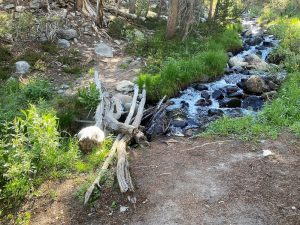 A small creek with logs strategically laid across it made crossing it pretty easy. This crossing looks about the same as it did last year but some years it is missing logs or people have added some. The trail then followed that creek up through some stretches with bouldery steps. And there were flowers, many different varieties, along the creek.
A small creek with logs strategically laid across it made crossing it pretty easy. This crossing looks about the same as it did last year but some years it is missing logs or people have added some. The trail then followed that creek up through some stretches with bouldery steps. And there were flowers, many different varieties, along the creek.
One of two different types of columbine on my hike, this one is Western Columbine, also locally called Crimson and Red Columbine.
 Beautiful Asters along the creek.
Beautiful Asters along the creek.
A member of the Mint family that we call Pennyroyal smelled heavenly to me!
I took a little peek into the Mine Creek drainage above Bennettville.
Small tarns shared some pretty reflections.
The trail then led me uphill toward a large rocky wash. I stopped periodically to listen for pika. I also stopped to admire the beautiful columbine that were really putting on a show with their multi colors. Tucked into crevices between colorful boulders, they provided unlimited interesting photo opportunities. My hiking buddy Gail researched the columbines in this area a few years ago and located some very interesting information about the columbine in this specific area from Wildflowers of the Sierra Nevada & Central Valley Field Guide. Alpine columbine and crimson columbine grow in different habitats at different elevations and are visited by different pollinators, but there are a few places in Yosemite at 9500-10,000′ where these two columbines hybridize. The result of this hybridization is a large, glorious white columbine with tinges of pinks, purples and yellow.
I took a look back towards where I had climbed and could also see the smoke from the Washburn Fire.
I continued climbing up the wash, peeking up Glacial Canyon toward Dana Lakes and Mt. Dana. Lucky for me, there was a nice breeze making this climb a bit cooler. The National Weather Service was forecasting a local wind called a Zephyr wind and it showed up as expected. Why is it called that you may ask? From Miriam Webster:
For centuries, poets have eulogized Zephyrus, the Greek god of the west wind, and his “swete breeth” (in the words of Geoffrey Chaucer). Zephyrus, the personified west wind, eventually evolved into zephyr, a word for a breeze that is westerly or gentle, or both.
Our Zephyr winds in this area can be not so gentle, gusting to 50 mph or so. The winds come and go but you can often hear them coming like a locomotive before they reach you. On this day I am guessing that I had gusts up to 30 mph or slightly higher.
That trail was a bit like a snake track in some places but I knew where we was going–up. The trail soon left the bottom of the wash and those beautiful columbines, then worked it’s way along the ridge. I took a breather, along with looking back where I had traveled.
When I made it out of the wash, I followed the trail until it petered out. Even without a trail to follow, it was easy to spot my destination, a high spot with a view. If you look in the middle of the picture at the tip top, there is a bit of a scraggly higher rocky area and that is it.
I had been doing serious pika watching since I had started up in the wash but couldn’t get a good picture. Well, I still didn’t get a good picture, but this helps show how well they blend in. If you enlarge the picture, you can see it better.
Just before I reached the highest point on my hike, the welcome committee came out to greet me.
And what a view it was from this spot looking down at Mono Lake!
I had some mighty pretty views all around me though. I could look straight across toward Mt. Dana, which towers over Glacier Canyon at 13,045′ elevation. It is the second highest mountain in Yosemite (after Mount Lyell) and is named after James Dwight Dana, who was a professor of geology at Yale College.
I could look across the plateau in the direction that I had come up and see the smoke plume from the Washburn Fire.
Looking toward the north.
Looking toward the south.
It was the perfect spot to take a lunch break and admire those views a bit more.
When you look across the Dana Plateau, it looks barren but when I walked across it, I could see that there were many tiny plants, many with flowers, tucked into small cracks and rocky areas.
I reached a high point that overlooked the Dana Lakes, formed when that ancient glacier retreated.
And I could look straight across at Mt. Dana and part of what remains of the Dana Glacier.
The Dana Glacier has continued to shrink over the years and there is a famous picture taken in 1883 by I. C. Russell that shows how much it has shrunk.
I wandered down the western edge of the plateau then met back up with the trail and continued back the same way I had come up.
Mariposa Lily flowers had fully opened up in the afternoon but getting a good picture in the breeze was a bit tricky, so I took a short video.
Butterflies love the Pennyroyal but capturing a good picture of them is a different story.
I made it down to Tioga Lake, back to the car and headed for the Tioga Entrance Gate. About 6 cars were in front of me and it took about 10 minutes for me to make my way through the gate, even with my yellow Day Use Vehicle Permit on my window.
And I had the road construction on the way back. I had about a 40 minute wait that started at Tuolumne Meadows then about 6 stops on the way through the construction. And that doesn’t count the wait at the Ferguson Slide. It was a long day with all of that construction waits.
I don’t want to make this hike seem too easy. Although it is short in length, there is a lot of elevation gain here and it is above 10,000′ elevation. It is important to be acclimated to hiking at this elevation and recognize the symptoms of altitude sickness when doing so. People do die of altitude sickness every year and this is a very real issue that people should be more aware of.
Altitude sickness occurs when you cannot get enough oxygen from the air at high altitudes. This causes symptoms such as a headache, loss of appetite, and trouble sleeping. It happens most often when people who are not used to high altitudes go quickly from lower altitudes to 8000 feet or higher, but it can occur to even a seasoned and conditioned hiker at times.
You can be adversely affected by the higher altitudes because the air is “thinner” at these high altitudes. When you go too high too fast, your body cannot get as much oxygen as it needs. This causes the headache and other symptoms of altitude sickness. As your body gets used to the altitude, the symptoms can go away.
These symptoms can include:
• A headache, usually throbbing, that gets worse during the night and when you wake up.
• Not feeling like eating.
• Feeling sick to your stomach. You may vomit.
• Feeling weak and lazy. In severe cases, you do not have the energy to eat, dress yourself, or do anything.
• Waking up in the night and not sleeping well.
• Feeling dizzy.
Your symptoms may be mild to severe. They may not start until a day after you have been at a high altitude. Some people say that having altitude sickness feels like having a hangover.
Altitude sickness can affect your lungs and your brain. When this happens, symptoms include being confused, not being able to walk straight, feeling faint, and having blue or gray lips or fingernails. When you breathe, you may hear a sound like a paper bag being crumpled. These symptoms mean the conditions are severe enough that they can be deadly.
Usually the best immediate treatment for altitude sickness is to go to a lower altitude. If your symptoms are mild, you may be able to stay at the elevation, take it easy, rest and make sure you keep yourself well hydrated.
If you are going to go on a hike at high altitude, learn about altitude sickness, the symptoms and how to treat it. It is very important that you look out for the other people in your group also. I have only briefly touched the subject of altitude sickness but felt it was important that it was on your radar should you decide to attempt a hike at elevations that are higher than you are used to. Altitude.org is a site where physicians who are knowledgeable about altitude sickness and associated illnesses have collected some information to share with the public. It has cautionary tales, a calculator where you can enter you’re your elevation to determine your percent oxygen that you will be breathing, along with detailed recommendations on the site. I used their calculator for our Dana Plateau hike and it showed that at our summit of 11,640′ elevation, we had 66% of normal oxygen at sea level. It even has a link that you can email them with questions if you have them. You can find them at Altitude Sickness .
Dog Hike?
Probably not. This hike is very steep through boulders and loose soil. For myself, it is difficult enough to climb up this trail without having to hold on to a dog. There are also sheer dropoffs at the top. This would not be a good hike for my dogs and I have never taken them up here for that reason. But you might be able to do the lower portion with your dog along the creek.
Here is some information from Inyo National Forest regarding their dog rules:
Traditionally, National Forests have welcomed dogs. However there are a few rules that apply to assure that you and other National Forest visitors have an enjoyable outdoor recreation experience. If you are camping with your pet, please practice the following:
General rules for dogs within the Inyo National Forest:
Doarama:
What is a Doarama? It is a video playback of the GPS track overlaid on a 3 dimensional interactive map. If you “grab” the map, you can tilt it or spin it and look at it from different viewing angles. With the rabbit and turtle buttons, you can also speed it up, slow it down or pause it.
Up and Around Dana Plateau Doarama
Map and Profile:
CALTOPO has some free options for mapping and here is a link to my hike this week, which you can view or download: CALTOPO: Up and Around Dana Plateau
Sources:
Ansel Adams Wilderness Wikipedia
Blackwell, Laird, Wildflowers of the Sierra Nevada & Central Valley Field Guide, Lone Pine Publisher, 1999
Monkshood Yosemite National Park
Glazner, Allen F. and Stock, Greg M., Geology Underfoot in Yosemite National Park, 2010.
Prior Blogs in the Area:
Hiking Dana Plateau July 8, 2021
Hiking From Tioga Lake Up To Dana Plateau June 13, 2020
Hiking Up, Down and Around Dana Plateau July 31, 2019
Hiking up to and around Dana Plateau July 9, 2018
Hiking up the Glacier Canyon Trail to Dana Plateau August 28, 2017
Hiking up to Dana Plateau August 3, 2016


